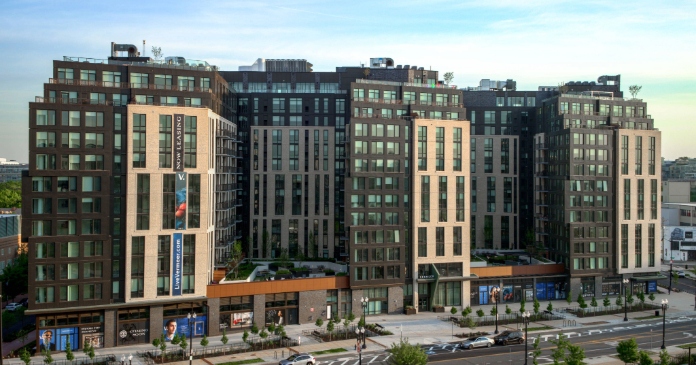The new locking technology that debuted at the National Association of Home Builders’ (NAHB) International Builders’ Show (IBS) in January isn’t based on the pin-and-tumbler mechanism that has been synonymous with locks since the Egyptians created a rough version around 4,000 years ago. SecureKey’s proprietary design simplifies the process of resetting a lock, when apartments turn or when residents request a lock change, to the simple turn of a key.
Unlike the pin-and-tumbler locks, which must be removed from the door and disassembled for re-keying, no special skills are required to change the SecureKey locks and deadbolts that have been making their way onto retail shelves since the product was introduced at IBS early this year.
The business that was founded in the 1920s as Schlage Lock Company by Walter Schlage and his business manager and partner, Charles Kendrick, in San Francisco and was purchased in 1974 by Ingersoll Rand, a manufacturer of industrial, mining and construction equipment, becoming part of the Ingersoll Rand Door Hardware Group, also has started a limited launch of the SecureKey Technology to its dealer base, like wholesalers HD Supply and Granger Industrial Supply, that serve single-family and multifamily builders and operators.
“Everything that’s going to be sold to a retailer is going to have SecureKey as the standard cylinder,” Eric Elsmore, multifamily marketing manager for Ingersoll Rand Residential Solutions, explained in May.
Multifamily builders, owners and managers will get the pin-and-tumbler locks as standard from the wholesalers. “SecureKey is the option they can specify, he said.
The good news for Schlage lock multifamily customers is that SecureKey doesn’t cost any more than the old pin-and-tumbler version.
The key savings
“It’s cost neutral,” Elsmore said. “The cost benefit or payback you’re deriving from using SecureKey over the standard pin-and-tumbler is the fact that the maintenance staff no longer has to re-key a lock or buy a new one. The lock can be re-keyed on the door.”
“We’ve found it takes about 20 minutes to re-key a pin-and-tumbler lock, which involves taking the lock off the door, re-pinning the cylinder and re-installing it. At your average size apartment community of 250 to 300 units, that can be quite a maintenance expense on an annual basis,” he said.
“The name of the product itself—SecureKey—alludes to the fact that the security is actually found in the proprietary key design,” explained Mike Holman, product manager for the new device that carries on the tradition for innovation that inspired the company’s founder to invent the first door lock that turned lights on and off in 1909, while working for Western Electric Company in San Francisco. Ten years later, he opened his own shop, where the first lock with a push-button device centered in the door knob, which was destined to revolutionize the door lock industry, was designed and produced.
And that industry-changing tradition continues today with the new locking system that can’t be forced into the re-key mode with a generic tool or foreign object. “You have to have a blue reset key that is the SecureKey, which is cut to be able to take the lock to the recombinating position and then also to take it out of the recombinating position,” he said, explaining that SecureKey lock and deadbolts come with a set that includes two brass keys and one blue reset key.
“The lock will be combinated to that particular key cut, so, as you’re doing the process of re-keying, you fully insert the blue reset key at the 12 o’clock position, so it’s straight up and down, just like any key that you might use to open the lock. Then you turn that key to the 11 o’clock position and remove it,” Holman explained.
The re-keying process is completed by inserting a new blue reset key in the lock at the 11 o’clock position, turning it to the straight-up position and pulling it out and the lock is re-keyed to the new set of keys, he said.
That familiar feeling
Competing products in the marketplace use a generic re-keying tool that isn’t a dedicated system. “With ours, you must have that original user-key that is key-cut to enable the lock to go into that recombination mode.”
“When we talk to consumers about our design concepts, they have a tremendous amount of confidence in a re-keying process that’s actually being done and completed successfully with a key, which is a thing we’re used to, opposed to the more generic re-keying tool that is foreign to them. So, it’s just an innate feeling that gives the consumer a greater amount of confidence in re-keying a lock with an actual key,” Holman said.
And, both the lock and the deadbolt cylinder are designed to defeat the most determined intruder. “We have a locking sidebar on one side of the deadbolt cylinder and another locking point on the other side to provide a fairly high degree of bump resistance,” Holman said.
Bumping, he explained, is an age-old technique used by locksmiths that involves inserting and tapping on a “bump key” that can open a lock by jimmying the pins into place one by one. “Locksmiths can do that if someone has lost their keys and doesn’t want to incur the expense of having to drill out the cylinder and potentially replace the lock,” he said of the technique that isn’t fail-safe, but is included as part of the certification process for locks and their ability to withstand the attack of an expert.
“UL 437 is the highest grade a cylinder can achieve, whether it’s a commercial or residential product. To get certified as UL 437, section 11.6, a lock has to withstand a 10-minute pick attack by someone with actual lock-picking tools. The cylinder does have that certification, as well,” Holman said.
And SecureKey Technology enables 10 times more key cut combinations, making homes 10 times more secure from key duplication, claims the company that lives by the motto: Real security sets you free.
Elsmore is confident that the product, which already is garnering enthusiastic testimonials from the companies that build and/or manage apartment communities, hits the sweet spot in the multifamily sector.
Renters will pay more for security
When renters were asked what they’d be willing to pay extra for at an apartment, in an October survey by Apartments.com, cylinder deadbolts on windows and doors were among the top five safety features that would entice 29 percent of the 750 renter survey respondents to pay more. In-unit security alarm systems could capture the pocketbooks of 49 percent of those surveyed, with 24/7 building security patrol guards and a doorman at 45 percent, while 42 percent of those surveyed consider security cameras in the apartment community important enough to pay more for, followed by 30 percent for mandatory background screening for all the residents.
Schlage can provide the products for many of those security amenities, Elsmore said of the Apartments.com survey results. “Where the Schlage portfolio comes head and shoulders above the rest is that, in addition to mechanical key solutions, there are several electronic credentials we use that are software solutions, so, we can satisfy any security or key-control requirement that a community has.
Schlage also provides the tools with which to create an entire security system and consultants to help develop and execute an apartment community safety plan.
“Some of the research that we’ve done indicates that, whether you’re renting or buying a new single-family home, security is the latent factor in determining where you’re going to live,” said Elsmore. “The locks and the access control systems on a property are really just one component of a bigger system, which includes proper lighting and having security personnel onsite, along with things like hedges being trimmed properly and limiting the number of personnel entrances.
“That’s the kind of thing our security consultants will talk to the property or community about when they go onsite to do a security consultation,” said Elsmore, adding that one of the biggest misconceptions people harbor about safeguarding their homes is that superior locks and access control are sufficient to protect their property. “It’s not,” he said. In fact, Schlage offers an American Institute of Architects presentation for which architects can earn credits by learning about creating safe multifamily communities, with the added benefit that Schlage products get exposure to the architectural community.
Getting the word out
This year’s multifamily-focused marketing campaign will launch at the Pacific Coast Builders Conference (PCBC) in San Francisco in June and, from there, the company, as has been its strategy the past few years, gets the word out to multifamily companies about new products through attendance at and participation in multifamily conferences throughout the year and affiliations with industry organizations like NAHB and the National Apartment Association. And Schlage’s association with mega-corporation Ingersoll Rand provides myriad opportunities to introduce new products to potential new customers, Elsmore said.
Schlage has introduced a number of industry-changing products over the past few years, ranging from the 2007 PCBC debut of the keyless Schlage Programmable Electronic Deadbolts and Access Control Management System, which substitutes keys with a programmable iButton, to this year’s SecureKey unveiling at IBS.
“From a portfolio standpoint, whether it’s mechanical locks or electronic access control, the whole multifamily theme comes zeroing back to key control. If it’s a basic mechanical system, we’ve got that covered. If you want to step up, we’ve got several key systems with additional restrictions on them. Then, past the mechanical continuum, is electronics, where we’ve had iButtons in products and now we’re getting into smart card—the network on a card. So, we can supply any type of access control and key control system you want to implement at an apartment community,” Elsmore said.
Author Peggy Shaw















